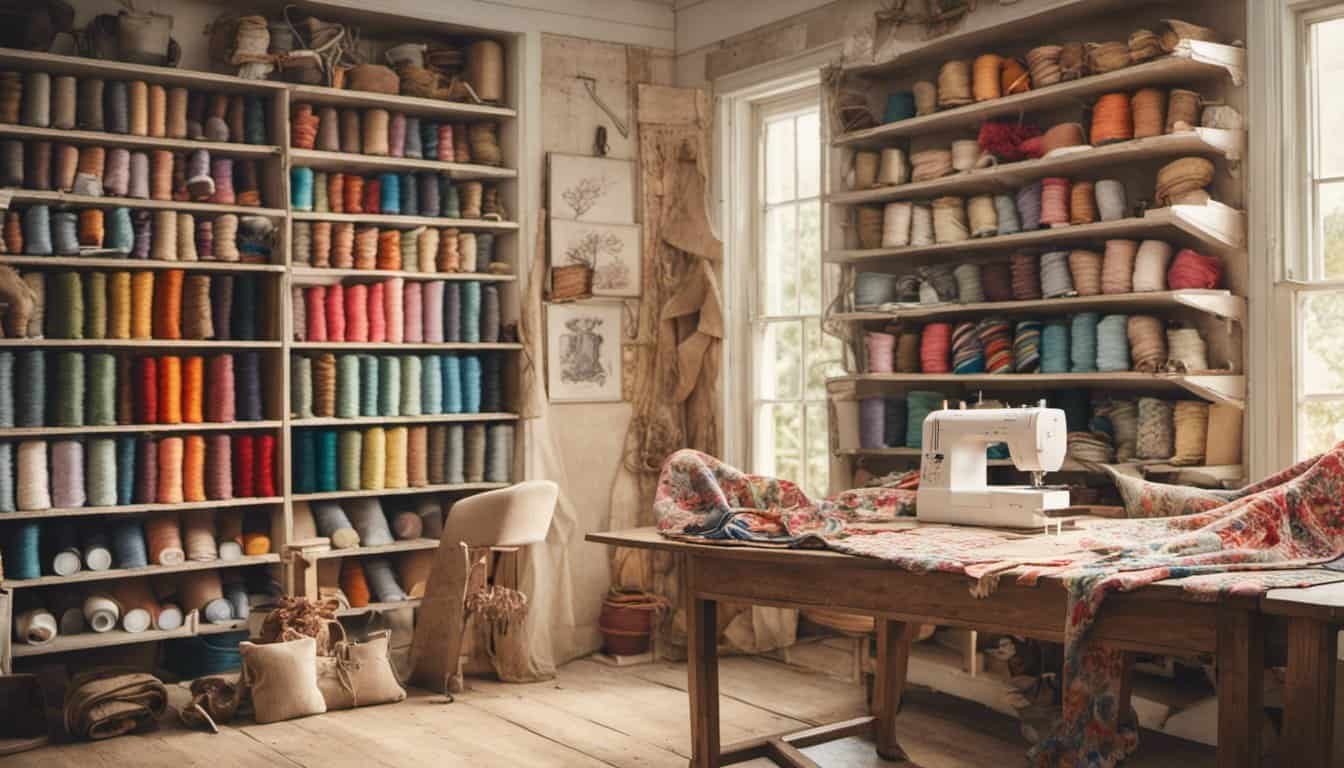Sewing a blouse with button details is such a rewarding project. There’s something so satisfying about creating a piece that’s not only stylish but also uniquely yours. Whether you’re a seasoned sewer or just starting out, adding buttons can take your blouse to the next level, giving it that polished, professional touch.
Choosing the Right Fabrics and Materials
Choosing appropriate fabrics and tools ensures a well-made blouse with durable button details. The right combination creates a professional, stylish finish.
Selecting Fabric Types for Blouses
I recommend soft, lightweight fabrics like cotton, silk, or rayon for blouses. These materials drape well and feel comfortable against the skin. For structured styles, opt for linen or chambray. To ensure the fabric can handle buttonholes, avoid stretchy materials like jersey unless working with stabilizers. Always test the fabric’s compatibility with your needle and sewing machine before starting.
Essential Tools for Sewing
Accurate cutting and stitching require specific tools. A fabric marker or tailor’s chalk helps mark button placements and seams cleanly. Sharp scissors are crucial for precise cuts, while glass-head pins hold fabric layers securely without leaving marks. A buttonhole foot attachment simplifies creating even buttonholes. Other essentials include an iron for pressing seams, thread matching the fabric color, and interfacing to reinforce the button areas.
Preparing Your Pattern
Ensuring a properly prepared pattern is key to creating a blouse with well-fitting button details. A precise start simplifies the sewing process and boosts your final result.
Choosing the Right Pattern
I recommend selecting a blouse pattern designed specifically for buttons. Patterns marked “classic fit,” “button-down,” or “front-closure” often include button placement guides. Look for options that match your skill level; beginner-friendly patterns usually have fewer technical components.
Examine the pattern pieces before starting. Check for design elements like darts, pleats, or panels that influence fit and button spacing. If you’re aiming for a tailored look, choose fitted patterns with shaping features. If you’re making a casual blouse, opt for a looser, relaxed cut.
Measuring and Adjusting the Fit
Accurate measurements prevent ill-fitting results. Use a tape measure to record bust, waist, and hip dimensions. Compare these to the pattern size chart, ensuring your chosen size aligns with your body.
If adjustments are needed, focus on areas like the bust for proper button closure and gape-free fit. Use pattern alteration techniques like adding or subtracting seam allowances or resizing darts. I often create a muslin (practice version) of the blouse to confirm fit before cutting the final fabric.
Adapting the pattern at this stage ensures a comfortable and flattering blouse with button details.
Cutting and Assembling the Blouse
This step focuses on transferring the pattern to your fabric and stitching the foundational framework of your blouse. Attention to detail during this stage ensures a flawless fit and clean construction.
Laying Out the Pattern
I start by ironing the fabric to remove wrinkles, ensuring flatness for accurate cutting. Placing the fabric on a large, flat, well-lit surface helps maintain proper alignment. I position the pattern pieces according to the grainline arrows, paying attention to directional prints or stretch requirements.
Using pattern weights or glass-head pins keeps the pieces secure while tracing. A fabric marker or tailor’s chalk works best for marking necessary notches, button placement, or darts directly onto the fabric.
Cutting the Fabric Pieces
I use sharp fabric scissors to make precise cuts along the traced lines. Smooth, continuous strokes prevent uneven edges that could disrupt seam accuracy. If working with slippery fabrics like silk, I layer it between tissue paper to stabilize it during cutting.

For perfectly matching front panels or design elements, I sometimes cut in double layers. This approach ensures symmetry, especially for garments with button closures.
Pinning and Sewing the Main Seams
I begin by pinning the fabric pieces with their right sides facing each other, aligning notches and marked points. Using glass-head pins keeps them securely in place while sewing. For curved seams or areas like darts, I prefer shorter pins for easier maneuvering.
I stitch the main seams on my sewing machine with a straight stitch, maintaining the seam allowances indicated in the pattern. Backstitching at the start and end of each seam ensures durability. For finished seams, I use pinking shears or an overcast stitch to prevent fraying, depending on the fabric type.
Adding Button Details
Incorporating button details transforms a simple blouse into a polished garment. Precise selection, placement, and attachment ensure the buttons enhance both design and functionality.
Choosing and Positioning Buttons
I carefully select buttons that complement the fabric and style of the blouse. For formal or classic styles, I might use small, flat buttons in neutral tones. For casual or playful designs, I explore decorative options like shell, wood, or metal finishes.
« Master the Art of Sewing a Halloween Costume: Witch Edition with These Enchanting Tips
I focus on proper positioning to balance the blouse’s fit and appearance. Button guides in patterns help determine placement, but I double-check alignment for accuracy. Spacing buttons 2.5-3 inches apart avoids gaping and ensures an even distribution, especially in areas like the bust or along darts. I use fabric markers or tailor’s chalk to mark button positions.
Creating Buttonholes
I make buttonholes after stitching the main blouse seams to maintain placement accuracy. Using a buttonhole foot attachment on my sewing machine, I set the length to match the button’s diameter plus 1/8 inch for easy closure.
I test buttonholes on fabric scraps to confirm tension and size before sewing on the actual blouse. For stabilizing lightweight fabrics, I back the buttonhole area with fusible interfacing. After stitching, I use a seam ripper to carefully cut open each buttonhole without damaging the stitches.
Attaching Buttons Securely
Attaching buttons securely ensures durability and functionality. I thread a hand-sewing needle with doubled thread, knot it at the end, and anchor stitches through the fabric to prevent fraying.
For flat buttons, I sew through each hole multiple times, creating an “X” or two parallel lines. For shank buttons, I loop thread through the shank for a snug yet flexible hold. Adding a small thread shank for flat buttons on thick fabrics prevents pulling and maintains a smooth finish. Once attached, I trim excess threads for a neat appearance.

Finishing Touches
Adding finishing touches to your blouse ensures a polished and professional result. These final steps not only enhance appearance but also improve durability and comfort.
Hemming and Seam Finishes
I find that hemming and seam finishes give a blouse its clean and refined look. To hem the blouse, I typically turn up the raw edge by about 0.25 inches, press it flat, and fold it again by 0.5 inches to encase the raw edge completely. Using a straight stitch, I sew close to the folded edge, ensuring the hem lies flat and secure. For curved hems, clipping the excess fabric before folding helps achieve a smooth finish.
For seam finishing, I prefer options like serging, pinking shears, or French seams, depending on the fabric type. On lightweight fabrics like silk or rayon, French seams create an elegant, hidden finish. Serged edges, on the other hand, are ideal for materials prone to fraying, like linen or chambray. Whatever method I choose, ensuring a neat finish prevents the seams from unraveling and boosts the garment’s lifespan.
Pressing the Blouse
Pressing each section of the blouse gives it a crisp, professional appearance. I recommend setting the iron to a heat level suitable for the specific fabric and beginning with the main seams. Pressing ensures the seams lie flat and blend seamlessly into the garment.
For details like button plackets, collars, and cuffs, I use a pressing cloth to avoid leaving marks on delicate fabrics. Even the smallest wrinkles can affect how the blouse drapes, so I pay attention to areas like darts and pleats for precise shaping. Steaming lighter fabrics can also restore their softness, while firmly pressing stiffer fabrics ensures a clean and tailored look.

Conclusion
Sewing a blouse with button details is such a fulfilling project. There’s nothing quite like the joy of turning fabric into a stylish, wearable piece that reflects your creativity. With the right tools, thoughtful preparation, and attention to detail, you can create a blouse that’s both beautiful and uniquely yours.
Don’t be afraid to experiment with fabrics, buttons, and styles to make it your own. Each blouse you sew will improve your skills and give you something special to add to your wardrobe. Happy sewing!

















